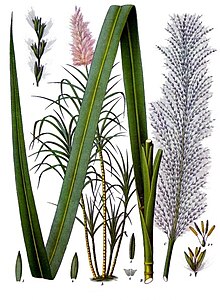Saccharum
| Saccharum | |
|---|---|

| |
| Saccharum officinarum[3] | |
| Scientific classification | |
| Kingdom: | Plantae |
| Clade: | Tracheophytes |
| Clade: | Angiosperms |
| Clade: | Monocots |
| Clade: | Commelinids |
| Order: | Poales |
| Family: | Poaceae |
| Subfamily: | Panicoideae |
| Supertribe: | Andropogonodae |
| Tribe: | Andropogoneae |
| Subtribe: | Saccharinae |
| Genus: | Saccharum L. |
| Type species | |
| Saccharum officinarum | |
| Synonyms[4] | |
| |
Saccharum is a genus of tall perennial plants of the broomsedge tribe within the grass family.[5]
The genus is widespread across tropical, subtropical, and warm temperate regions in Africa, Eurasia, Australia, the Americas, and assorted oceanic islands. Several species are cultivated and naturalized in areas outside their native habitats.[6][7][8][9][10][11][12][13]
Saccharum includes the sugarcanes. They have stout, jointed, fibrous stalks that are generally rich in sugar, and measure two to six m (6 to 19 ft) tall. All sugarcane species interbreed and the major commercial cultivars are complex hybrids.
Species
As of September 2021[update], Plants of the World Online accepted the following species:[4]
- Saccharum alopecuroidum (L.) Nutt. - southeastern USA
- Saccharum angustifolium (Nees) Trin. - South America
- Saccharum asperum (Nees) Steud. - South America
- Saccharum baldwinii Spreng. - southeastern USA
- Saccharum beccarii (Stapf) Cope - Sumatra
- Saccharum brevibarbe (Michx.) Pers. - southeastern USA
- Saccharum coarctatum (Fern.) R. Webster - southeastern USA
- Saccharum contortum (Baldwin ex Elliott) Nutt. - southeastern USA
- Saccharum fallax Balansa - China, Assam, southeast Asia
- Saccharum filifolium Steud. - Afghanistan, Himalayas
- Saccharum formosanum (Stapf) Ohwi - southern China
- Saccharum giganteum (Walt.) Pers. - southeastern USA, Cuba, Jamaica, Paraguay, Argentina
- Saccharum griffithii Munro ex Aitch. - from Yemen to Bangladesh
- Saccharum intermedium Welker & Peichoto
- Saccharum kajkaiense (Melderis) Melderis - Oman, Iran, Afghanistan, Pakistan
- Saccharum longesetosum (Andersson) V.Naray. ex Bor - China, Himalayas, Indochina
- Saccharum maximum (Brongn.) Trin. - Pacific Islands
- Saccharum narenga (Nees ex Steud.) Hack. - China, Indian Subcontinent, Indochina, Ethiopia
- Saccharum officinarum L. - New Guinea; naturalized in many warm places
- Saccharum robustum Brandes & Jesw. ex Grassl - New Guinea
- Saccharum rufipilum Steud. - China, Indian Subcontinent, Indochina
- Saccharum sikkimense (Hook.f.) V.Naray. ex Bor - eastern Himalayas
- Saccharum × sinense Roxb. – China
- Saccharum spontaneum L. - Asia, Africa, Sicily, Papuasia
- Saccharum stewartii Rajesw., R.R.Rao & Arti Garg - western Himalayas
- Saccharum velutinum (Holttum) Cope - Peninsular Malaysia
- Saccharum villosum Steud. - South America, Mesoamerica
- Saccharum wardii (Bor) Bor ex Cope - Assam, Bhutan, Myanmar
- Saccharum williamsii (Bor) Bor ex Cope - Nepal
Placed in Lasiorhachis by Plants of the World Online as of September 2021[update]:[14]
- Saccharum hildebrandtii (Hack.) Clayton → Lasiorhachis hildebrandtii
- Saccharum perrieri (A.Camus) Clayton. → Lasiorhachis perrieri
- Saccharum viguieri (A.Camus) Clayton → Lasiorhachis viguieri
Placed in Tripidium by Plants of the World Online as of September 2021[update]:[15]
- Saccharum arundinaceum Retz. - East + South + Southeast Asia; New Guinea → Tripidium arundinaceum
- Saccharum bengalense Retz. - India, Pakistan, Iran, Afghanistan → Tripidium bengalense
- Saccharum kanashiroi (Ohwi) Ohwi - Ryukyu Islands → Tripidium kanashiroi
- Saccharum procerum Roxb. - China, Himalayas, Indochina → Tripidium procerum
- Saccharum ravennae (L.) L. - Europe, Asia, Africa → Tripidium ravennae
- Saccharum strictum (Host) Spreng. - from Italy to Iran → Tripidium strictum
Formerly included
Numerous species are now considered better suited in other genera: Andropogon, Chloris, Digitaria, Eriochrysis, Eulalia, Gynerium, Hemarthria, Imperata, Lophopogon, Melinis, Miscanthus, Panicum, Pappophorum, Paspalum, Perotis, Pogonatherum, Pseudopogonatherum, Spodiopogon, and Tricholaena.[6]
See also
References
- ^ lectotype designated by Hitchcock, Prop. Brit. Bot. 119 (1929)
- ^ Tropicos, Saccharum L.
- ^ 1897 illustration from Franz Eugen Köhler, Köhler's Medizinal-Pflanzen
- ^ a b "Saccharum L.". Plants of the World Online. Royal Botanic Gardens, Kew. Retrieved 2021-09-05.
- ^ Linnaeus, Carl von. 1753. Species Plantarum 1: 54 in Latin
- ^ a b Kew World Checklist of Selected Plant Families
- ^ Flora of China Vol. 22 Page 576 甘蔗属 gan zhe shu Saccharum Linnaeus, Sp. Pl. 1: 54. 1753.
- ^ Flora of Pakistan, Saccharum Linn., Sp. Pl. 1: 54. 1753. Gen. Pl., ed. 5; 28.1754
- ^ Biota of North America Program 2013 county distribution maps
- ^ Catasus Guerra, L. 1997. Las gramíneas (Poaceae) de Cuba, I. Fontqueria 46: [i–ii], 1–259.
- ^ Davidse, G. & R. W. Pohl. 1994. 146. Saccharum L. 6: 378–379. In G. Davidse, M. Sousa Sánchez & A.O. Chater (eds.) Flora Mesoamericana. Universidad Nacional Autónoma de México, México, D.F.
- ^ Phillips, S. 1995. Poaceae (Gramineae). Flora of Ethiopia 7: i–xx, 1–420.
- ^ Welker, C. A. D. & H. M. Longhi-Wagner. 2012. The genera Eriochrysis P. Beauv., Imperata Cirillo and Saccharum L. (Poaceae - Andropogoneae - Saccharinae) in the state of Rio Grande do Sul, Brazil. Brazilian Journal of Botany 35(1): 87–105.
- ^ "Lasiorhachis (Hack.) Stapf". Plants of the World Online. Royal Botanic Gardens, Kew. Retrieved 2021-09-05.
- ^ "Tripidium H.Scholz". Plants of the World Online. Royal Botanic Gardens, Kew. Retrieved 2021-09-04.
External links
Saccharum.
